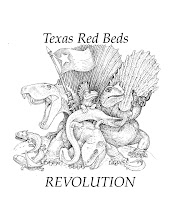The team split up early on - one half worked on the K2 site, where 7 Seymouria bones had been uncovered previously. Last night, we wondered if the find was a fluke, or if there was more to be discovered.
The answer - definitely more to be found. The team at K2 uncovered two distinct horizontal layers, about 2 feet apart, each with it's own Edaphosaurus remains. Even more astounding - the fossils are in place, not eroding out of the soil.

So, this individual is still resting as he died and was covered over by soil 285 million years ago. By taking directional and GPS readings of the fossils' locations, the team can figure out how the body was manipulated by external forces after death - like river currents.

In addition, the team found a wide diversity of other Permian species, including Captorhinus, Seymouria, Diadectes, Diplocaulus, Eryops - and Dimetrodon, in the form of 9 shed teeth, proof that the Texas Finback was feeding here, most likely on Daffys. A very rare, very small Dimetrodon toe bone was also found.
UPDATE: In this video, Dr. Bakker explains what has been uncovered as a new layer in the K2 site.The biggest question from this site is posed by the multiple Edaphosaurus individuals - there are multiple deaths and multiple burials of a very rare species, in one spot. Why?

The other half of the team headed out to Edge - a site a few miles away that was discovered on the Teachers' Expedition last summer. A complete Dimetrodon hip was uncovered on the surface, and this half of the team worked on prospecting the entire canyon in which Edge is located, to find additional sites that should be excavated.


Hundreds of perfect examples - uncrushed, with the recognized spiral pattern - were found. They range in size, but none are particularly large. According to Dr. Bakker, this means that "there was age segregation among the sharks here. This was a middle school for sharks." No poison spines are found here - which is unusual as well. David Temple, who discovered the site, will post a description of the experience here tomorrow.
They also found a site with Dimetrodon fin spines in place, next to a vertebra.

At another, they found a fossil Calamites - a large leafy plant with beautiful striations, or fine lines, throughout the leaves, as well as fragments of petrified wood that might be large enough to tell us what kinds of trees were growing here in the Permian.

Fragments of petrified wood found at a new site in the Edge canyon.
Overall, the Edge environments are completely different from K2. At Edge, no shed teeth were found; the Dimetrodon site represented only one individual, rather than the many individuals of many species found at most other sites; bones are articulated, with pieces that are still attached or that easily click together; and reduction zones are present - tiny green areas in the red soil representing the presence of organic material - like worms or roots - that prevented the soil from oxidizing. There is also lots of sandstone - each layer represents the river overflowing its banks, covering any dead animals and facilitating the process of fossilization, but also preventing these animals from being eaten - which makes figuring out their ecosystem more difficult.
The team regrouped toward the end of the day to focus on excavating the K2 site, and to prospect at Nicole - a nearby site where many Lyserophian burrows have been found. Another giant Edaphosaurus vertebra was found at this site as well, along with what might be fossilized shark cartilage.

A tiny vertebra found at the main K2 site this afternoon; Dr. Bakker believes it to be the smallest he has ever seen.
As if that weren't enough excitement for one day, they also found lots of big, very clear arthropod footprints in pale blue-gray sandstone just as the sun set - the first such tracks found at this site.
As Dr. Bakker said today, and as we are all discovering, "every site has its own character; and yet, there are patterns." Check back with us tomorrow to see what other patterns are developing.



